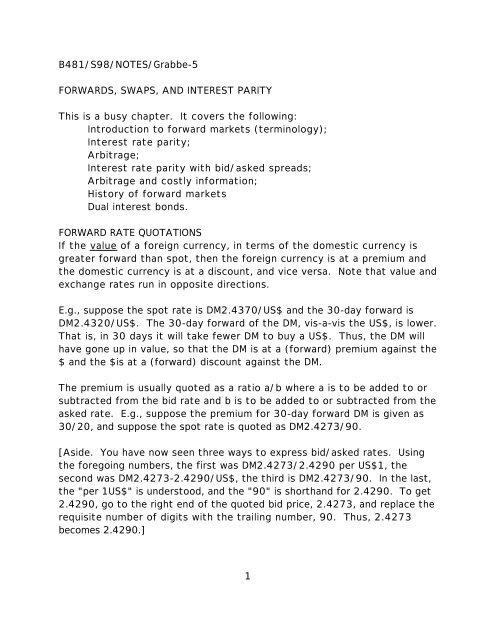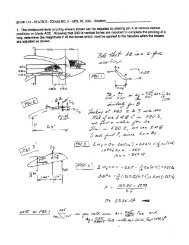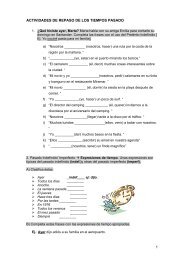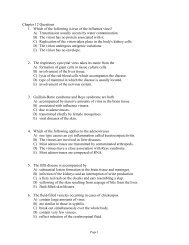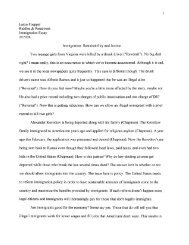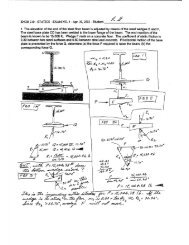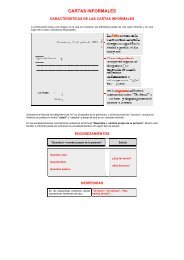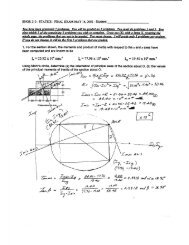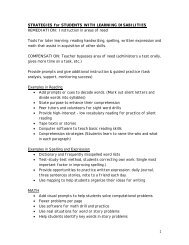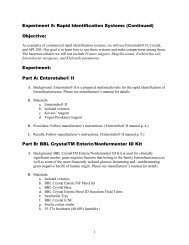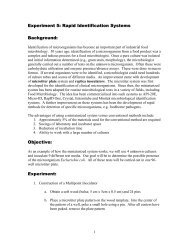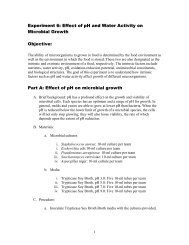B481/S98/NOTES/Grabbe-5 FORWARDS, SWAPS, AND INTEREST ...
B481/S98/NOTES/Grabbe-5 FORWARDS, SWAPS, AND INTEREST ...
B481/S98/NOTES/Grabbe-5 FORWARDS, SWAPS, AND INTEREST ...
Create successful ePaper yourself
Turn your PDF publications into a flip-book with our unique Google optimized e-Paper software.
<strong>B481</strong>/<strong>S98</strong>/<strong>NOTES</strong>/<strong>Grabbe</strong>-5<br />
<strong>FORWARDS</strong>, <strong>SWAPS</strong>, <strong>AND</strong> <strong>INTEREST</strong> PARITY<br />
This is a busy chapter. It covers the following:<br />
Introduction to forward markets (terminology);<br />
Interest rate parity;<br />
Arbitrage;<br />
Interest rate parity with bid/asked spreads;<br />
Arbitrage and costly information;<br />
History of forward markets<br />
Dual interest bonds.<br />
FORWARD RATE QUOTATIONS<br />
If the value of a foreign currency, in terms of the domestic currency is<br />
greater forward than spot, then the foreign currency is at a premium and<br />
the domestic currency is at a discount, and vice versa. Note that value and<br />
exchange rates run in opposite directions.<br />
E.g., suppose the spot rate is DM2.4370/US$ and the 30-day forward is<br />
DM2.4320/US$. The 30-day forward of the DM, vis-a-vis the US$, is lower.<br />
That is, in 30 days it will take fewer DM to buy a US$. Thus, the DM will<br />
have gone up in value, so that the DM is at a (forward) premium against the<br />
$ and the $is at a (forward) discount against the DM.<br />
The premium is usually quoted as a ratio a/b where a is to be added to or<br />
subtracted from the bid rate and b is to be added to or subtracted from the<br />
asked rate. E.g., suppose the premium for 30-day forward DM is given as<br />
30/20, and suppose the spot rate is quoted as DM2.4273/90.<br />
[Aside. You have now seen three ways to express bid/asked rates. Using<br />
the foregoing numbers, the first was DM2.4273/2.4290 per US$1, the<br />
second was DM2.4273-2.4290/US$, the third is DM2.4273/90. In the last,<br />
the "per 1US$" is understood, and the "90" is shorthand for 2.4290. To get<br />
2.4290, go to the right end of the quoted bid price, 2.4273, and replace the<br />
requisite number of digits with the trailing number, 90. Thus, 2.4273<br />
becomes 2.4290.]<br />
1
The quoted DM2.4273/90 is equivalent to DM2.4273-2.4290/US$, and the<br />
30/20 is simply the amounts to be subtracted from 2.4273 and 2.4290,<br />
respectively.<br />
Question -- How did we know to subtract See page 105 for the rule:<br />
(form 1) spreads always get bigger<br />
(form 2) for a/b, if a > b, then subtract; if a < b, then add.<br />
Clearly, form 2 is the easier to remember. But it is ad hoc; so you should<br />
understand the logic behind firm 1.<br />
Example 5.1<br />
Suppose the spot rate is DM2.5005/10 per US$ and the one-month forward<br />
margins are 100/95. Find the one-month outright forward rates.<br />
Since 100 > 95, i.e., we have the a > b case. Therefore, we subtract.<br />
The spot bid-asked is DM2.5005 - 2.5010 and the forward margin is<br />
100/95. Thus, the one-month forward bid/asked is DM2.4905 - 2.4915,<br />
which would be quoted as DM2.4905/10. Note that since the forward rate<br />
ius lower than the spot rate, the DM is at a premium against the US$.<br />
Suppose, however, the one-month forward margins are quoted as 95/100<br />
and the spot rates are as given above. Find the one-month outright<br />
forward rates.<br />
Now we have 95 < 100, i.e., we have the a < b case. Therefore, we<br />
add. The spot bid-asked is DM2.5005 - 2.5010 and the forward margin is<br />
95/100. Adding, we have the one-month forward bid/asked as DM2.5100 -<br />
2.5110, which would be quoted as DM2.5100/10.<br />
<strong>INTEREST</strong> PARITY<br />
This section starts out in exactly the right direction. The issue is Where<br />
do premiums and discounts come from The answer is interest rates, and<br />
the relationship between forward rates, spot rates, and interest rates is<br />
called interest parity. Actually, there are two such conditions, one riskfree,<br />
called ‘covered’, and the other risky, called ‘uncovered’. The<br />
equations are easy to derive, since they result from an arbitrage<br />
condition.<br />
2
First, we must consider the conventions surrounding the quoting of<br />
interest rates. The key point is this -- eurocurrency interest rates are<br />
stated as annual rates. For example, if the interest rate is 8% and the<br />
deposit is for 30 days, then the 30-day hence value of a $1 deposit is<br />
$ ( 1 + .08( 30<br />
360 ) ) = $ 1 . 0066 6 .<br />
1<br />
12<br />
Note that it is not ( 1 + .08) . The second key point is that for most<br />
currencies there are 360 days in the year. However, for the British and<br />
Australian dollars there are 365 days in the year. Thus, a £1 30-day<br />
deposit at 8% has a maturity value of<br />
£ ( 1 + .08( 30<br />
365 )) = £ 1 . 006575.<br />
For ease of exposition, we will assume that there is only one value for<br />
each of the spot, forward, and interest rates.<br />
NOTATION<br />
S(t) = the domestic currency price of spot foreign exchange at time t<br />
F(t, T) = the domestic currency price of forward foreign exchange at time<br />
t for a contract that matures at time t+T.<br />
(E.g., if the domestic currency is the US$, then the spot rate for the DM<br />
might be S(t) = US$0.40/DM.)<br />
i = the yearly interest rate paid on eurocurrency deposits denominated in<br />
the domestic currency<br />
i* = the yearly interest rate paid on eurocurrency deposits denominated in<br />
the foreign currency<br />
For ease of exposition, suppose the two currencies are 360 days/year<br />
currencies.<br />
3
COVERED <strong>INTEREST</strong> ARBITRAGE<br />
The derivation here is slightly “reversed” from that given in the text.<br />
Note that here we begin holding a foreign currency; in the text we begin by<br />
borrowing US$.<br />
Suppose we start with X units of the currency of a country C. We can<br />
convert the C-currency into US$ at today’s spot rate S(t). This yields<br />
S(t)X US$. These US$ can be deposited for a period of T days in a<br />
eurocurrency account paying i. When mature, this deposit is worth<br />
(1+i(T/360))S(t)X US$. Finally, we can convert this amount, without risk,<br />
in currency-C at the forward rate for time t+T. Thus, leaving S(t) and<br />
F(t+T) stated in the same terms, we have as the time t+T value, in<br />
currency-C, as (1+i(T/360))S(t)X(1/F(t+T)). Alternatively, we could have<br />
simply deposited the X units of C-currency at the interest rate i*. This<br />
would yield at time t+T a value, in C-currency, of (1+i*(T/360))X. There<br />
are no arbitrage profits if and only if these two values are equal, i.e., if<br />
and only if<br />
(1+i(T/360))S(t)X(1/F(t+T)) = (1+i*(T/360))X.<br />
Eliminating X and rearranging terms, we have the famous (covered)<br />
interest parity condition:<br />
F ( t + T ) = S( t ) [ 1 + i ( T<br />
)]<br />
360<br />
[ 1 + i ∗ ( T<br />
)] .<br />
360<br />
Now note that if i > ( ( S(t), then it costs more US$<br />
in the future to buy one unit of C-currency. Thus, if i > i*, so that F(t+T) ><br />
S(t), then the US$ is at a discount and the C-currency is at a premium.<br />
Similarly, if i < i*, so that F(t+T) < S(t), then the US$ is at a premium and<br />
the C-currency is at a discount. Finally, if i* = i, so that F(t+T) = S(t),<br />
then the US$ and the C-currency are at parity.<br />
4
Graphically, we have the following:<br />
C-currency<br />
X C-currency<br />
US$<br />
S(t)X US$<br />
S(t) $/C<br />
i* i<br />
F(t+T) $/C<br />
indirect:<br />
1<br />
[1+i*(T/360)]S(t)<br />
F ( t + T ) X<br />
[1+i*(T/360)]S(t)X<br />
direct:<br />
[1+i(T/360)]X<br />
5
Example 5.2<br />
Suppose S(t) = US$.40000/DM and the one-year forward rate F(t,T) =<br />
US$.40026/DM. Assume the contract will mature in T = 365 days from the<br />
spot value date. Suppose the rates on eurodollar and euro-DM deposits are<br />
i = 11.3% and i* = 6.0%. The example, like the text derivation of the<br />
interest parity condition, compares domestic borrowing with covered<br />
foreign lending. Suppose we begin by borrowing one US$. Then we must<br />
pay back, in 365 days, $(1+i(T/360)) = $(1+0.113(365/360)) = $1.114569.<br />
If we take the borrowed US$ and buy DM, deposit the DM and sell the total<br />
forward, then we would receive $(1/S(t))(1+i*(T/360))F(t,T) =<br />
$(1/.40)(1+.06(365/360))(.42026) = $1.114565. As noted, these two<br />
values are sufficiently close that arbitrage is not likely to be possible.<br />
Thus, the currencies are at interest parity.<br />
<strong>INTEREST</strong> PARITY <strong>AND</strong> <strong>SWAPS</strong><br />
The key question here is What is the relationship between interbank swaps<br />
and the interest parity theorem There are many answers.<br />
First, the swap rate should be the difference F(t,T) - S(t). Rearranging the<br />
interest parity theorem yields<br />
F(t,T) - S(t) = S ( t ) 1 + i ( T<br />
) 360<br />
1 + i ∗ ( T<br />
) − 1 = S ( t ) ( i - i * )( T<br />
) 360<br />
1 + i ∗ ( T<br />
) .<br />
360 360<br />
Marketmaking banks use the interest parity theorem to quote forward<br />
rates. This removes the risk of quoting swap rates that are<br />
disadvantageous to a bank.<br />
Note that eurocurrency interest rates are used, in lieu of other interest<br />
rates, because the former are set in accordance with the presumptions<br />
behind the derivation of the interest parity theorem.<br />
Example 5.3<br />
This example, while simple, shows the role of banks, which have access to<br />
the interbank market, in the FX market.<br />
6
DIVERGENCES FROM <strong>INTEREST</strong> PARITY<br />
Like the perfect gas laws, the interest parity theorem often fails to hold.<br />
Also like the perfect gas laws, it fails to hold because markets, etc. are<br />
not perfect. However, the interest parity theorem is used to detect<br />
arbitrage opportunities and to compare hedging costs.<br />
Example 5.4 (Arbitrage Profits)<br />
Suppose we have the following conditions:<br />
S(t) = US$0.40/DM<br />
F(t,T) = US$0.42/DM for T = 360 days<br />
i = 10% (US$)<br />
i* = 6% (DM)<br />
Does an arbitrage opportunity exist To answer this question, we check<br />
to see if the interest parity equation holds.<br />
The equation is F ( t + T ) = S( t ) [ 1 + i ( T<br />
)]<br />
360<br />
. The left-hand-side is , by<br />
[ 1 + i ∗ ( T<br />
)] 360<br />
observation, F(t,360) = US$0.42/DM. The right-hand-side is<br />
S ( t ) [ 1 + i ( T<br />
)]<br />
360<br />
[ 1 + i ∗ ( T<br />
360<br />
360<br />
[ 1 + . 10(<br />
= ( US$ . 40/ DM) )]<br />
360<br />
)] = US$ . 41509 / DM.<br />
[ 1 + . 06( 360<br />
)] 360<br />
The actual forward rate, US$0.42/DM, is larger than the synthetic forward<br />
rate, US$.41509/DM, so arbitrage is possible. Note that the interbank<br />
trader can borrow US$1 at 10%, convert the US$ to DM at DM/.40US$,<br />
deposit the DM at 6%, and convert the resulting DM to US$ at US$.42/DM,<br />
yielding US$1.113. The difference, US$1.113 - US$1.10 = US$0.013 is the<br />
trader's profit (per dollar) On a deal involving $1,000,000, the profit is<br />
$13,000.<br />
Note that the interest parity equation tells you whether there is an<br />
arbitrage profit to be had. The box diagram and its related calculations<br />
tells you the size of the profit.<br />
7
Hedging Costs<br />
The interest parity equation can be used to determine an optimal hedging<br />
plan. The key point is that a corporation, if it faces interest rates, does<br />
not face the interbank eurocurrency rates. Corporations rarely engage in<br />
currency arbitrage, but they regularly engage in hedging.<br />
Example 5.5 (Hedging Costs)<br />
Suppose a US corp. must pay DM2million in 6 months (180 days). The corp.<br />
can borrow US$ at 10% or DM at 5.5%. The relevant exchange rates are S(t)<br />
= US$.3752/DM and F(t,180) = US$.3900/DM. The corp. wishes to lock in<br />
the US$ cost of the DM2million now. How should it do so<br />
The possibilities are to hedge via the forward market and to use a money<br />
market equivalent. We need simply to compare the two. Of course, they<br />
are the two sides to the interest parity equation.<br />
The hedge requires the corp. to buy forward DM$2million, which costs<br />
(DM2million)(US$.3900/DM) = $780,000 to be paid in 180 days.<br />
The money market equivalent is to acquire and deposit sufficiently many<br />
DM to generate DM2million, at 5.5%, in 180 days. Thus, we need to find X<br />
where [1+.055(180/360)]X = 2million. Clearly, X = DM1,946,472. To<br />
acquire DM1,946,472 today, the corp. must borrow US$ in the amount<br />
(DM1,946,472)(US$.3752/DM) = $730,316.30. If the corp. borrows this<br />
amount today, it will have to pay back ($730,316.30)[1+.10(180/360)] =<br />
$766,832.12 in 180 days.<br />
Thus, we have two comparable numbers:<br />
the hedge costs $780,000 to be paid in 180 days;<br />
the money market plan costs $766,832.12 to be paid in 180 days.<br />
Clearly, the money market plan costs less and should be adopted.<br />
The key point is this -- the corp. faces interest rates other than the<br />
eurocurrency rates. Therefore, the interest parity equation does not hold<br />
for the rates faced by the corp. Hence, the equation provides a means for<br />
determining the superior plan. Note that we have ignored, for simplicity,<br />
both the bid/asked form of exchange rates and transactions costs.<br />
8
<strong>INTEREST</strong> PARITY WITH BID/ASKED SPREADS<br />
Notation:<br />
Sb(t) = the bid spot rate at time t<br />
Sa(t) = the asked spot rate at time t<br />
Fb(t,T) = the bid forward rate at time t for T days hence<br />
Fa(t,T) = the asked forward rate at time t for T days hence<br />
ib = the bid eurocurrency interest rate on the domestic currency<br />
ia = the asked eurocurrency interest rate on the domestic currency<br />
ib* = the bid eurocurrency interest rate on the foreign currency<br />
ia* = the asked eurocurrency interest rate on the foreign currency<br />
Assume a 360 day year. If a trader engages in arbitrage, then the trader<br />
must buy (or borrow) at the other party's asked rate, and he will sell or<br />
lend at the bid rate. there are two approaches to arbitrage -- borrow<br />
domestic currency and borrow foreign currency.<br />
9
Borrow Domestic Currency<br />
The trader can borrow 1/[1+ia(T/360)] units of domestic currency at time<br />
t and repay 1 unit of domestic currency at time t+T. Using the domestic<br />
currency at time t, the trader can sell the currency forward while placing<br />
the foreign currency on deposit at ib*. The spot rate Sa(t), the forward<br />
rate Fb(t,T) and the interest rate ib* determine the value of the hedge via<br />
1 1<br />
the equation<br />
[ 1 + ib( T / 360) ] Fb( t , T ). To see this, simply<br />
[ 1 + ia( T / 360] Sa( t )<br />
fill-in the box diagram, as follows:<br />
DOMESTIC CURRENCY<br />
time t:<br />
1<br />
borrow<br />
[ 1 + ia( T / 360]<br />
FOREIGN CURRENCY<br />
1<br />
receive<br />
[ 1 + ia( T / 360]<br />
1<br />
Sa( t )<br />
Sa(t) $/for.<br />
ia<br />
ib*<br />
Fb(t+T) $/for.<br />
time t+T<br />
direct:<br />
owe 1 unit<br />
indirect: receive [ 1 + ib∗ ( T / 360) ]<br />
[ 1 + ia( T / 360]<br />
Fb( t , T )<br />
Sa( t )<br />
receive [ 1 + ib* ( T / 360) ]<br />
[ 1 + ia( T / 360]<br />
1<br />
Sa( t )<br />
10
Clearly, arbitrage profits exist if and only if the trader receives more, at<br />
time t+T, from the indirect route than he owes via the direct route.<br />
Therefore, arbitrage is not profitable if and only if<br />
[ 1 + ib ∗ ( T / 360) ] Fb( t , T )<br />
< 1.<br />
[ 1 + ia( T / 360] Sa( t )<br />
Rearranging terms yields the following: no arbitrage profits exist if and<br />
only if<br />
[ 1 + ia( T / 360) ]<br />
Fb( t , T ) # Sa( t )<br />
[ 1 + ib ∗ ( T / 360) ] .<br />
Note that this is only half of the system. The trader could have gone in<br />
“the other direction” by borrowing foreign currency, converting to US$,<br />
depositing the US$, and converting them back to foreign currency. This<br />
procedure is parallel to the foregoing, and provides the other half of the<br />
system.<br />
11
Borrow Foreign Currency<br />
The trader can<br />
The trader can borrow 1/[1+ia*(T/360)] units of foreign currency at time<br />
t and repay 1 unit of foreign currency at time t+T. Using the foreign<br />
currency at time t, the trader can sell the currency forward while placing<br />
the domestic currency on deposit at ib. The spot rate Sb(t), the forward<br />
rate Fa(t,T) and the interest rate ib determine the value of the hedge via<br />
1<br />
the equation<br />
Sb( t )[ 1 + ib( T / 360) ]( 1 / Fa( t , T )). To see this,<br />
[ 1 + ia ∗ ( T / 360]<br />
simply fill-in the box diagram, as follows:<br />
DOMESTIC CURRENCY<br />
FOREIGN CURRENCY<br />
time t:<br />
1<br />
receive<br />
[ 1 + ia ∗ ( T / 360] Sb(t) borrow 1<br />
[ 1 + ia ∗ ( T / 360]<br />
Sb(t) $/for.<br />
ib<br />
ia*<br />
Fa(t+T) $/for.<br />
time t+T<br />
direct:<br />
indirect: receive<br />
[ 1 + ib( T / 360) ]<br />
[ 1 + ia * ( T / 360]<br />
owe 1 unit<br />
Sb( t ) receive<br />
[ 1 + ib( T / 360) ]<br />
[ 1 + ia ∗ ( T / 360]<br />
Sb( t )<br />
Fa( t , T )<br />
12
Clearly, arbitrage profits exist if and only if the trader receives more, at<br />
time t+T, from the indirect than he owes via the direct route. Therefore,<br />
arbitrage is not profitable if and only if<br />
[ 1 + ib( T / 360) ] Sb( t )<br />
[ 1 + ia ∗ ( T / 360] Fa( t , T ) < 1.<br />
Rearranging terms yields the following: no arbitrage profits exist if and<br />
only if<br />
[ 1 + ib( T / 360) ]<br />
Fa( t , T ) $ Sb( t )<br />
[ 1 + ia ∗ ( T / 360) ] .<br />
Note that a trader always has both paths available for arbitraging the<br />
market. Therefore, there are no arbitrage profits if and only if both of the<br />
foregoing inequalities hold simultaneously. Thus, we have the following:<br />
no arbitrage profits exist if and only if<br />
and<br />
[ 1 + ia( T / 360) ]<br />
Fb( t , T ) # Sa( t )<br />
[ 1 + ib ∗ ( T / 360) ]<br />
Fa( t , T ) $ Sb( t )<br />
[ 1 + ib( T / 360) ]<br />
[ 1 + ia ∗ ( T / 360) ] .<br />
Example 5.6<br />
This example puts the two halves of the system together. Suppose we<br />
have S(t) = US$.4428-.4438/DM and F(t,30 days) = US$.4450-.4460/DM.<br />
The rate on one-month euro-DM is 5 7<br />
( = 5 . 875) to 6 percent, while the<br />
rate on one-month eurodollars is 10 11<br />
percent. Is there an arbitrage possibility<br />
8<br />
16<br />
( = 10. 6875) to 10<br />
13<br />
16<br />
= ( 10. 8125)<br />
13
First, consider borrowing dollars. We have the following:<br />
Sa = US$ .4438/DM<br />
Fb = US$.4450/DM<br />
ia = 10 13<br />
= ( 10. 8125) percent<br />
ib* = 5 7<br />
16<br />
8<br />
( = 5 . 875) percent<br />
1<br />
If we borrow<br />
= 1<br />
dollars, convert them<br />
[ 1 + ia( T / 360] [ 1 + . 108125( 30 / 360) ]<br />
at the spot rate Sa = US$.4438/DM, place them at the interest rate ib* =<br />
5 7<br />
8<br />
percent, and convert the DM back to US$ at Fb = US$.4450/DM, then we<br />
will receive [ 1 + ib∗ ( T / 360) ]<br />
[ 1 + ia( T / 360]<br />
Fb( t , T )<br />
Sa( t )<br />
=<br />
[ 1 + . 05875( 30 / 360) ]<br />
[ 1 + . 108125( 30 / 360) ]<br />
. 4450<br />
. 4438 = $.9986.<br />
Since this is less than the US$1 that we owe, there are no profits in<br />
arbitrage via borrowing US$.<br />
Now, consider borrowing foreign currency. We have the following:<br />
Sb = US$ .4428/DM<br />
Fa = US$.4460/DM<br />
ib = 10 11<br />
( = 10. 6875) percent<br />
16<br />
ia* = 6 percent<br />
If we borrow<br />
1<br />
[ 1 + ia * ( T / 360] = 1<br />
[ 1 + . 06( 30 / 360) ]<br />
DM, convert them at the<br />
spot rate Sb = US$.4428/DM, place them at the interest rate ib = 10 11<br />
percent, and convert the US$ back to DM at Fa = US$.4460/DM, then we will<br />
[ 1 + ib( T / 360) ] Sb( t ) [ 1 + . 106875( 30 / 360) ] . 4428<br />
receive =<br />
[ 1 + ia ∗ ( T / 360] Fa( t , T ) [ 1 + . 06( 30 / 360) ] . 4460 = DM.9966.<br />
Since this is less than the DM1 that we owe, there are no arbitrage profits<br />
in arbitrage via borrowing DM.<br />
Therefore, there are no arbitrage profits in the setting described by the<br />
data given here.<br />
16<br />
14
The no-arbitrage conditions are<br />
[ 1 + ia( T / 360) ]<br />
Fb( t , T ) # Sa( t )<br />
[ 1 + ib ∗ ( T / 360) ] = Sa( t )[ 1 + ia( T / 360) ]<br />
= Y<br />
[ 1 + ib ∗ ( T / 360) ]<br />
and<br />
[ 1 + ib( T / 360) ]<br />
Fa( t , T ) $ Sb( t )<br />
[ 1 + ia ∗ ( T / 360) ] = Sb( t )[ 1 + ib( T / 360) ]<br />
= X.<br />
[ 1 + ia ∗ ( T / 360) ]<br />
Note that Sa > Sb and ia > ib, so that [1+ia(T/360)] > [1+ib(T/360)]. Thus,<br />
the numerator of Y is greater than the numerator of X. Furthermore, note<br />
that ia* > ib*, so that [1+ia*(T/360)] > 1+ib*(T/360)]. Thus, the<br />
denominator of X is greater than the denominator of Y. Therefore, Y > X.<br />
Diagrammatically, we have the following:<br />
Fb(t,T) < Y<br />
Fa(t,T) > X<br />
range of F(t,T)<br />
0<br />
X Y<br />
If X < Fb(t,T) < Fa(t,T) < Y, then there are no arbitrage profits. If Fa(t,T) < X<br />
or Fb(t,T) > Y, then arbitrage profits exits, but of only one kind. That is, if<br />
Fa(t,T) < X, then we can make arbitrage profits by borrowing foreign<br />
currency, and if F(t,T) > Y, then we can make arbitrage profits by<br />
borrowing US$. But, we can not have both, since then we would have<br />
Fa < X < Y < Fb which is inconsistent with Fb < Fa.<br />
15
Example 5.6 displayed a case wherein no arbitrage profits were available<br />
to an interbank trader. However, that does not mean that a corporation<br />
would be indifferent to hedging at the rates given in Example 5.6. This<br />
case is displayed in Example 5.7<br />
Example 5.7.<br />
Consider the data given in Example 5.6 and a corporation that does not<br />
engage in arbitrage but is sufficiently large to have access to the<br />
interbank market. Suppose the corporation is buying DM for payment 30<br />
days hence. The corp. can go in either of two directions:<br />
#1 -- The corp. can set aside US$, collect interest (at the US$ rate),<br />
and sell the US$ forward for DM.<br />
#2 -- The corp. can buy spot DM and deposit the DM at the DM<br />
interest rate.<br />
The data is as follows:<br />
Sa = US$ .4438/DM<br />
Sb = US$ .4428/DM<br />
Fb = US$.4450/DM<br />
Fa = US$.4460/DM<br />
ia = 10 13<br />
= ( 10. 8125) percent ib = 10 11<br />
( = 10. 6875) percent<br />
ib* = 5 7<br />
16<br />
8<br />
( = 5 . 875) percent ia* = 6 percent<br />
16<br />
If the corp. takes path #1, then for each US$ set aside, it will receive, 30<br />
1<br />
days hence, DM in the amount 1 [ 1 + ib( T / 360) ]<br />
Fa( t , T ) =<br />
1 [ 1 + . 108675( 30 / 360) ]<br />
1<br />
. 4460 = DM2.2621.<br />
16
To see this, consider the box diagram, as follows:<br />
DOMESTIC CURRENCY<br />
time t:<br />
set aside US$1<br />
FOREIGN CURRENCY<br />
ib<br />
Fa(t+T)<br />
time t+T:<br />
receive 1[ 1 + ib( T / 360) ]<br />
= 1 [ 1 + . 106875( 30/ 360) ]<br />
1<br />
receive 1[ 1 + ib( T / 360) ]<br />
Fa( t , T )<br />
1<br />
= 1 [ 1 + . 106875( 30/ 360) ]<br />
. 4460<br />
= DM2 . 2621<br />
17
Alternatively, the corp. could take path #2, i.e., buy spot DM and deposit the DM<br />
at the DM interest rate. Then, for each US$, it will receive, 30 days hence, DM in<br />
1<br />
the amount 1<br />
Sa( t ) [ 1 + ib 1<br />
∗ ( T / 360) ] =1 [ 1 + . 05875( 30 / 360) ] = DM2.2643.<br />
. 4438<br />
To see this, again consider the box diagram, as follows:<br />
DOMESTIC CURRENCY (US$)<br />
time t:<br />
US$1 receive 1<br />
Sa(t)<br />
FOREIGN CURRENCY (DM)<br />
1<br />
Sa( t ) = 1 1<br />
. 4438<br />
ib*<br />
time t+T:<br />
receive 1 1<br />
Sa( t ) [ 1 + ib∗ ( T / 360) ]<br />
1<br />
= 1 [ 1 + . 05875( 30/ 360) ]<br />
. 4438<br />
= DM2 . 2643<br />
Thus, the second path, using the spot rate and the money market, yields more DM<br />
then the first path, using the forward market, and therefore would be the<br />
preferred hedge.<br />
18
<strong>INTEREST</strong> PARITY <strong>AND</strong> THE COST OF INFORMATION<br />
The foregoing examples make a serious point -- the forward market is not<br />
necessarily the superior route for a hedge. Note that if the interest parity<br />
equation holds exactly, then both the forward market hedge and the money<br />
market hedge will yield the same result. However, if the interest parity<br />
equation does not hold exactly, then one of these two is superior to the other.<br />
Note <strong>Grabbe</strong>'s discussion of the difference between the information effects<br />
from a corp. that is continuously in the interbank market and one that is in the<br />
market only occasionally. Herein lies the grounds for concluding that the money<br />
market is not inefficient.<br />
We will return to the issues surrounding information costs later.<br />
FORWARD MARKETS <strong>AND</strong> <strong>INTEREST</strong> RATES: HISTORICAL BACKGROUND<br />
This section hits four interesting points:<br />
(1) The FX forward market starts in Vienna;<br />
(2) The FX forward market was considered to be mysterious even after<br />
Keynes explained its inner workings in 1922;<br />
(3) The hedging calculations shown in the foregoing example are done<br />
rather matter-of-factly by modern financial mangers;<br />
(4) Most of the empirical tests of the interest parity equation are<br />
seriously flawed.<br />
19
FORWARD CONTRACTS <strong>AND</strong> DUAL CURRENCY BONDS<br />
Dual currency bonds are quite simple, though they may sound complex. A dual<br />
currency bond is a bond that is purchased in terms of one currency -- with<br />
coupon interest paid in that currency -- but is redeemed in terms of another<br />
currency. The text example is the dual currency bond issued in 1985 where each<br />
bond could be purchased for its full face value of SF5,000. Interest on the bonds<br />
is paid in SF. At maturity (in 10 years), the bond principle is repaid in the<br />
amount of US$2,800.<br />
The key point is this -- a dual currency bond is equivalent to a standard bond<br />
together with a forward contract. (See, e.g., Thomas J. O'Brien, Global Financial<br />
Management, pp. 141-143.) Thus, since forward contracts lock-in exchange<br />
SF5 , 000<br />
rates, the locked-in exchange rate for this bond is<br />
US$ 2 , 800 = SF1.7857/US$.<br />
As with all forward contracts, a dual currency bond allows the individual to<br />
speculate against future exchange rates.<br />
<strong>Grabbe</strong> notes that one may wish to use a dual currency bond when the market is<br />
not quoting forward rates for a particular time. The example <strong>Grabbe</strong> uses is a<br />
10 year forward on SF. Typically, one can not obtain forward rates for a 10 year<br />
horizon.<br />
20


